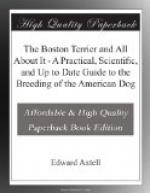“The force of nature could no further
go,
To make a third, she joined the
other two.”
And this applies with equal force to the production of the Boston terrier. The two old standard breeds of world-wide reputation, the English bulldog and the bull terrier, had to be joined to make a third which we believe to be the peer of either, and the superior of both. The dog thus evolved possesses a type and individuality strictly his own, inherited from both sides of the house, and is a happy medium between these two grand breeds, possessing the best qualities of each. To some the name “terrier” would suggest the formation of the dog on approximate terrier lines, but this is as completely erroneous as to imagine that the dog should approach in like proportion to the bull type. When the dog was in its infancy it was frequently called the Boston bull, and then again the round-headed bull and terrier, and later, when the Boston Terrier Club was taken under the wings of the great A.K.C. in 1893, it became officially known as the Boston terrier.
There are several features that are characteristic of the dog that tend to its universal popularity—its attractive shape, style and size, its winning disposition, and its beautiful color and markings. From the bulldog he inherits a sweet, charming personality, quiet, restful demeanor, and an intense love of his master and home. He does not possess the restless, roving disposition which characterizes so many members of the terrier tribe, nor will he be found quarreling with other dogs. From the bull terrier side he inherits a lively mood, the quality of taking care of himself if attacked by another dog, and of his owner, too, if necessary, the propensity to be a great destroyer of all kinds of vermin if properly trained, and an ideal watch dog at night. No wonder he is popular, he deserves to be. The standard describes him as follows:
“The general appearance of the Boston terrier is that of a smooth, short-coated, compactly built dog of medium station. The head should indicate a high degree of intelligence and should be in proportion to the dog’s size; the body rather short and well knit, the limbs strong and finely turned, no feature being so prominent that the dog appears badly proportioned. The dog conveys an impression of determination, strength and activity, style of a high order and carriage easy and graceful.”
The men composing the Boston Terrier Club, who framed this standard in 1900, were as thoughtful a body as could possibly be gotten together, and they carefully considered and deliberated over every point at issue, and in my estimation this standard is as near perfect as any can be. I was an interested participant in the discussion of the same, having in my mind’s eye as models those two noted dogs owned by that wonderful judge of the breed, Mr. Alex. Goode, Champion Monte, and his illustrious sire, Buster. If one takes the pains to analyze the standard he will be impressed by the perfect co-relation of harmony of all parts of the dog, from the tip of his broad, even muzzle, to the end of his short screw tail. Nothing incongruous in its makeup presents itself, but a graceful, symmetrical style characterizes the dog, and I firmly believe that any change whatever would be a detriment.




